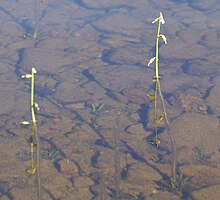Lobelia dortmanna
| Lobelia dortmanna | |
|---|---|
 |
|
| Plants in pond habitat | |
| Scientific classification | |
| Kingdom: | Plantae |
| (unranked): | Angiosperms |
| (unranked): | Eudicots |
| (unranked): | Asterids |
| Order: | Asterales |
| Family: | Campanulaceae |
| Subfamily: | Lobelioideae |
| Genus: | Lobelia |
| Species: | L. dortmanna |
| Binomial name | |
|
Lobelia dortmanna L. |
|
Lobelia dortmanna (Dortmann's cardinalflower or water lobelia) is an aquatic stoloniferous herbaceous perennial aquatic plant with basal rosettes, and flower stalks growing to 70–200 cm tall. The flowers are 1–2 cm long, with a five-lobed white to pale pink or pale blue corolla, produced one to ten on an erect raceme held above the water surface. The fruit is a capsule 5–10 mm long and 3–5 mm wide, containing numerous small seeds.
The leaves are linear to oblong, 2.5–7.5 cm long and evergreen. They have no functional stomata. It is one of several unrelated species of plants from low nutrient lakes known as isoetids, owing to their superficial similarity to Isoetes. The plant has the unusual ability of removing carbon dioxide from the rooting zone rather than from the atmosphere.
L. dortmanna is native to cool temperate regions of northern Europe (the British Isles and northwest France east to northwest Russia) and northern North America (both coasts; Newfoundland south to New Jersey and west to the Great Lakes in the east, and British Columbia south to Oregon in the west).
It typically occurs in shallow water on sandy, peaty or rocky lakeshores, in pools, and in some kinds of wetlands. It is rarely found in rivers. Low water periods may leave it temporarily emersed, although it is sensitive to prolonged emersion and is one of the first species to be lost when water levels in lakes are artificially managed.
...
Wikipedia
